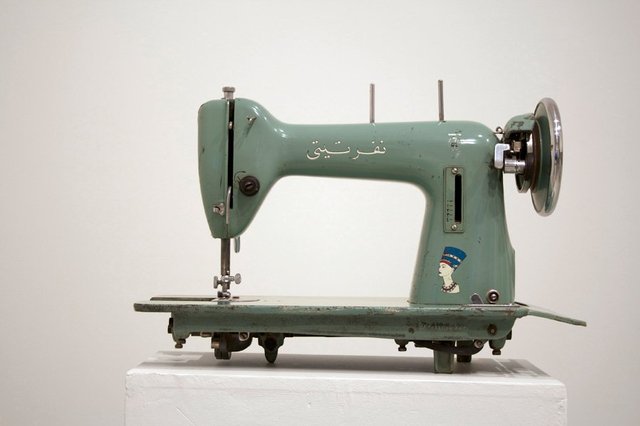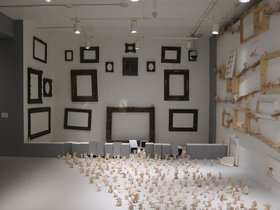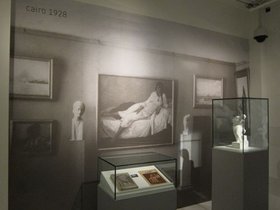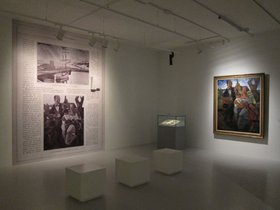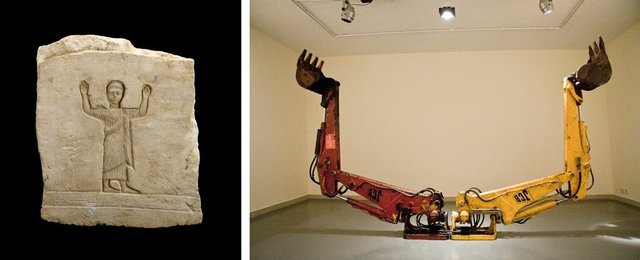Reviews
Tea With Nefertiti
The Making of the Artwork by the Artist, the Museum and the Public
The German-Lebanese curatorial partners Till Fellrath and Sam Bardaouil, who are the founders of the curatorial platform Art Reoriented, are no strangers to Doha's Arab Museum of Modern Art, Mathaf. In 2010, they curated the institution's inaugural exhibition Told | Untold | Retold showing contemporary Arab artists whose work, in some way or another, focused on the theme of storytelling. Their second venture at Mathaf, Tea with Nefertiti: The Making of the Artwork by the Artist, the Museum and the Public, went into a completely different direction, though the interest in narrative, be it (art) historical or other remained intact. From the get-go there was tension between the playful title of the show and its emphatic, if not pedagogical, subtitle. Having an imaginary tea party with an historical and cultural icon does not immediately square with the laborious art historical task of deconstructing the authorial, institutional and public manifestations of art works. However, Tea with Nefertiti admirably brought together Egyptian antiquities and more than 40 European and Arab modern masters and contemporary artists, precisely because it refuted certain museological conventions.
Purist art critics might frown at the sight of young Egyptian artist Bassem Youssri's little white clay figurines that seem to symbolie an 'everyman/woman', staring at a 1911 Amarna-style inspired drawing of Amadeo Modigliani or a 1965 bust by Alberto Giacometti, but in a humorous way, these little characters broke down the (art) historical sanctity of these works. These little figures function as a miniature reminder that art, in essence, is always meant for an audience.
On that note, the fact that the hosting institution, the Mathaf[1], is itself very much a museum in the making offers an interesting subtext to Tea with Nefertiti. It is almost as if the very premise of the exhibition, which intends to unmoor artworks from their interpretative labels and art historical shackles, are tested in a museum that – until now – has espoused the very opposite with its permanent collection exhibitions of modern Arab art. This is also what made Tea with Nefertiti such an interesting experiment; up to a point it could not escape the constraints of its own format, namely 'the exhibition'. It seems Bardaouil and Fellrath knew this and instead of artificially stretching exhibition concepts and formats, they dug deep into its very structure. This inevitably led to the rather unimaginative components cited in the subtitle: The Artwork, the Museum and the Public, and might come across as a course in 'exhibition-making 1.0.' Perhaps to a certain extent it was, because there have been few curatorial exercises that try to cut through 2000 years of artistic cross-cultural practices that aim to reframe Egyptian art, without attempting to be conclusive or do something representative.
In effect, by taking Nefertiti as a case study and examining how she has been treated as a figure and as an object of art, the exhibition became its own microcosm with its own logic. In the 'Artist' chapter of the exhibition, photographer Youssef Nabil's well-known close-up portrait of Nefertiti's bust taken in 2003 focused on the beauty of the artifice, while Candida Höffer's 2009 photograph in the 'Museum' chapter showed Nefertiti in a glass vitrine within the opulent interior of Berlin's Neues Museum. In Höffer's image it was as much about the setting as it was about the art object. In the 'Public' chapter we found Ala Younis' 2008 installation Nefertiti, which consists of a video and 5 displayed sewing machines of the Nefertiti brand – made in Egypt during the 1950s. The Nefertiti sewing machine brought together the industrial and modernist ambitions of the Nasserite era with the glorification of the Pharaonic period. Both the sewing machine as a commodity, as well as the modernist ideology it was born from, seem removed from public view, and have become relics of the past. This being said, Pharaonic and Nasserite imagery continue to be dominant markers for Egyptian identity, albeit that these markers are more steeped in nostalgia than anything else.[2]
Grappling with the past and its material manifestations, whether revering, reviling, neglecting or erasing it is something that was continuously challenged in this exhibition. Take for example Emily Jacir's short video A Sketch in the Egyptian Museum (2003) where she captures the cleaning staff in Cairo's Egyptian Museum wiping a century-old steel far too vigorously, as if it were a piece of dusty furniture in need of a good scrub. The dismal state of the conservation of precious antiquities in the Egyptian Museum is not a secret but Jacir's video presented the fragility of the life of objects, and how national heritage is squandered because of corruption, incompetence or disinterest. Vik Muniz, on the other hand, went pop in playful Tupperware Sarcophagus with a mummy preserved in a life-size Tupperware box. He renders the stereotypical character of ancient Egypt, the mummy, as something that is almost disposable, kept and preserved in commercial and easily reproducible plastic. By doing this he not only humorously updates the preservation technique for this ancient figure to the 21st century, but also recasts the mummy as an ancient leftover in a culture of throwaway consumer capitalism.
One of the most revealing parts of the show in terms of temporal experience was to be found in the 'Museum' section that traces the exhibition history of the works of renowned modern Egyptian artists such as sculptor Mahmoud Moukhtar (1891-1934) and Georges Sabbagh (1871-1951). Their oeuvre was revisited through actual works placed next to exhibition documentation from the 1920s and 1930s, the original exhibition catalogues, and press cuttings. These moments were akin to beingthrown into a time machine, but the physical presence of the artworks kept one foot in the present. Indeed if there is anything like an art historical wormhole, it is this accumulation of archival material.
Tea with Nefertiti was a heavily curated exhibition, and at times the curatorial voice was a bit laboured. For example, the visual correspondence between Palestinian-American artist Nida Sinnokrot's installation of two bulldozer arms pointing up to the heavens and a 1st century AD Terethunis stele of a man repeating the same gesture of arms pointing to the heavens is a bit far-fetched, and too much of a historical stretch. Nevertheless, most of the time the co-relations between the pieces across timelines, continents and artistic practices was riveting, and truly scrambled preconceived ideas of an icon through the format of the exhibition. If Bardaouil's and Fellrath's aim was to 'liberate both artwork and artist from the labels of art historical narrative that have become deeply entangled with cause and effect, geography, identity, and cultural specificity and political and social engagement' they did so in an original and formidable way.
Tea with Nefertiti was on show at Mathaf, Arab Museum of Modern Art Doha, Qatar, from 17th November 2012 to 31st March 2013. It will be on view at the Institut du Monde Arabe in Paris, until 8th September 2013.
[1]Mathaf, the Arab museum of Modern Art in Doha (QA) opened its doors in 2010. Its collections comes predominantly from the private collection of modern Arab art of Sheikh Hassan bin Mohamed bin Ali Al Thani. Mathaf is a unique institution in the Gulf because unlike the Louvre or Guggenheim it is not importing an international brand identity. Since its inception its curatorial and institutional challenge has been how to develop a vision that consolidates modern and contemporary Arab art and how to translate this vision into public programming for a country where appreciation for the arts is still nascent.
[2] Both the Pharaonic and Nasserite period reference times when Egypt was an international powerhouse to reckon with. In 1952 Colonel Gamal Abdel Nasser lead the Egyptian revolution and overthrew the monarchy of King Farouk; an ideologically propitious period of pan-Arabism and Arab nationalism follows in the 1950s and 1960s. Nasser remains for many in Egypt, and the Arab world at large, an icon of Arab unification, independence and modernity. Pharaonic and Nasserite imagery can be found in Egyptian cinema, pop culture, tourist souvenirs, and political posters as icons of a strong and forward-looking Egypt.

